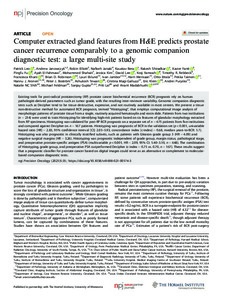Computer extracted gland features from H&E predicts prostate cancer recurrence comparably to a genomic companion diagnostic test: a large multi-site study
Khani Francesca; Taimen Pekka; Eklund Lauri; Robinson Brian D.; Feldman Michael; Rebbeck Timothy R.; Tewari Ashutosh; Magi-Galluzzi Cristina; Janaki Nafiseh; Klein Eric; Gupta Sanjay; Leo Patrick; Jambor Ivan; Yamoah Kosj; El-Fahmawi Ayah; Merisaari Harri; Purysko Andrei; Lal Priti; Shahait Mohammed; Fu Pingfu; Shih Natalie NC; Madabhushi Anant; Ettala Otto; Aronen Hannu J.; Shiradkar Rakesh; Boström Peter J.; Janowczyk Andrew; Farré Xavier; Lee David; Bera Kaustav; Elliott Robin; Kim Jessica
Computer extracted gland features from H&E predicts prostate cancer recurrence comparably to a genomic companion diagnostic test: a large multi-site study
Khani Francesca
Taimen Pekka
Eklund Lauri
Robinson Brian D.
Feldman Michael
Rebbeck Timothy R.
Tewari Ashutosh
Magi-Galluzzi Cristina
Janaki Nafiseh
Klein Eric
Gupta Sanjay
Leo Patrick
Jambor Ivan
Yamoah Kosj
El-Fahmawi Ayah
Merisaari Harri
Purysko Andrei
Lal Priti
Shahait Mohammed
Fu Pingfu
Shih Natalie NC
Madabhushi Anant
Ettala Otto
Aronen Hannu J.
Shiradkar Rakesh
Boström Peter J.
Janowczyk Andrew
Farré Xavier
Lee David
Bera Kaustav
Elliott Robin
Kim Jessica
NATURE RESEARCH
Julkaisun pysyvä osoite on:
https://urn.fi/URN:NBN:fi-fe2021100750273
https://urn.fi/URN:NBN:fi-fe2021100750273
Tiivistelmä
Existing tools for post-radical prostatectomy (RP) prostate cancer biochemical recurrence (BCR) prognosis rely on human pathologist-derived parameters such as tumor grade, with the resulting inter-reviewer variability. Genomic companion diagnostic tests such as Decipher tend to be tissue destructive, expensive, and not routinely available in most centers. We present a tissue non-destructive method for automated BCR prognosis, termed "Histotyping", that employs computational image analysis of morphologic patterns of prostate tissue from a single, routinely acquired hematoxylin and eosin slide. Patients from two institutions (n = 214) were used to train Histotyping for identifying high-risk patients based on six features of glandular morphology extracted from RP specimens. Histotyping was validated for post-RP BCR prognosis on a separate set of n = 675 patients from five institutions and compared against Decipher on n = 167 patients. Histotyping was prognostic of BCR in the validation set (p < 0.001, univariable hazard ratio [HR] = 2.83, 95% confidence interval [CI]: 2.03-3.93, concordance index [c-index] = 0.68, median years-to-BCR: 1.7). Histotyping was also prognostic in clinically stratified subsets, such as patients with Gleason grade group 3 (HR = 4.09) and negative surgical margins (HR = 3.26). Histotyping was prognostic independent of grade group, margin status, pathological stage, and preoperative prostate-specific antigen (PSA) (multivariable p < 0.001, HR = 2.09, 95% CI: 1.40-3.10, n = 648). The combination of Histotyping, grade group, and preoperative PSA outperformed Decipher (c-index = 0.75 vs. 0.70, n = 167). These results suggest that a prognostic classifier for prostate cancer based on digital images could serve as an alternative or complement to molecular-based companion diagnostic tests.
Kokoelmat
- Rinnakkaistallenteet [19207]
